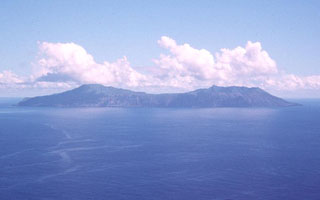Report on Anatahan (United States) — September 2009
Bulletin of the Global Volcanism Network, vol. 34, no. 9 (September 2009)
Managing Editor: Richard Wunderman.
Anatahan (United States) Quiet except for brief tremor in February 2009 and plume in June 2009
Please cite this report as:
Global Volcanism Program, 2009. Report on Anatahan (United States) (Wunderman, R., ed.). Bulletin of the Global Volcanism Network, 34:9. Smithsonian Institution. https://doi.org/10.5479/si.GVP.BGVN200909-284200
Anatahan
United States
16.35°N, 145.67°E; summit elev. 790 m
All times are local (unless otherwise noted)
Our most recent report on Anatahan (BGVN 33:12) discussed sulfur dioxide emissions and steam plumes during 2008. This report covers activity between January and October 2009.
A team of research scientists from the University of Tokyo and Kyushu University visited the volcano during the week of 19 January. They worked with the Emergency Management Office of the Commonwealth of the Northern Mariana Islands (CNMI) to perform seismic station maintenance. The team observed no unusual volcanic phenomena. Seismic levels remained low, and no anomalies were observed in satellite imagery.
The U.S. Geological Survey (USGS) reported that seismic activity at Anatahan during the first half of 2009 was generally at background levels. On 11 February a brief episode of tremor occurred. A low level plume was observed in satellite images on 13 June, but there was no evidence that it contained ash. Nothing unusual was observed in satellite images throughout the rest of the week. According to the USGS, Anatahan was quiet as of 6 November.
Geological Summary. The elongate, 9-km-long island of Anatahan in the central Mariana Islands consists of a large stratovolcano with a 2.3 x 5 km compound summit caldera. The larger western portion of the caldera is 2.3 x 3 km wide, and its western rim forms the island's high point. Ponded lava flows overlain by pyroclastic deposits fill the floor of the western caldera, whose SW side is cut by a fresh-looking smaller crater. The 2-km-wide eastern portion of the caldera contained a steep-walled inner crater whose floor prior to the 2003 eruption was only 68 m above sea level. A submarine cone, named NE Anatahan, rises to within 460 m of the sea surface on the NE flank, and numerous other submarine vents are found on the NE-to-SE flanks. Sparseness of vegetation on the most recent lava flows had indicated that they were of Holocene age, but the first historical eruption did not occur until May 2003, when a large explosive eruption took place forming a new crater inside the eastern caldera.
Information Contacts: Dina Venezky, Volcano Hazards Program, U.S. Geological Survey, 345 Middlefield Road, MS 910, Menlo Park, CA 94025, USA (URL: http://volcanoes.usgs.gov/); Emergency Management Office, Commonwealth of the Northern Mariana Islands, PO Box 100007, Saipan, MP 96950, USA (URL: http://www.cnmihsem.gov.mp/).

